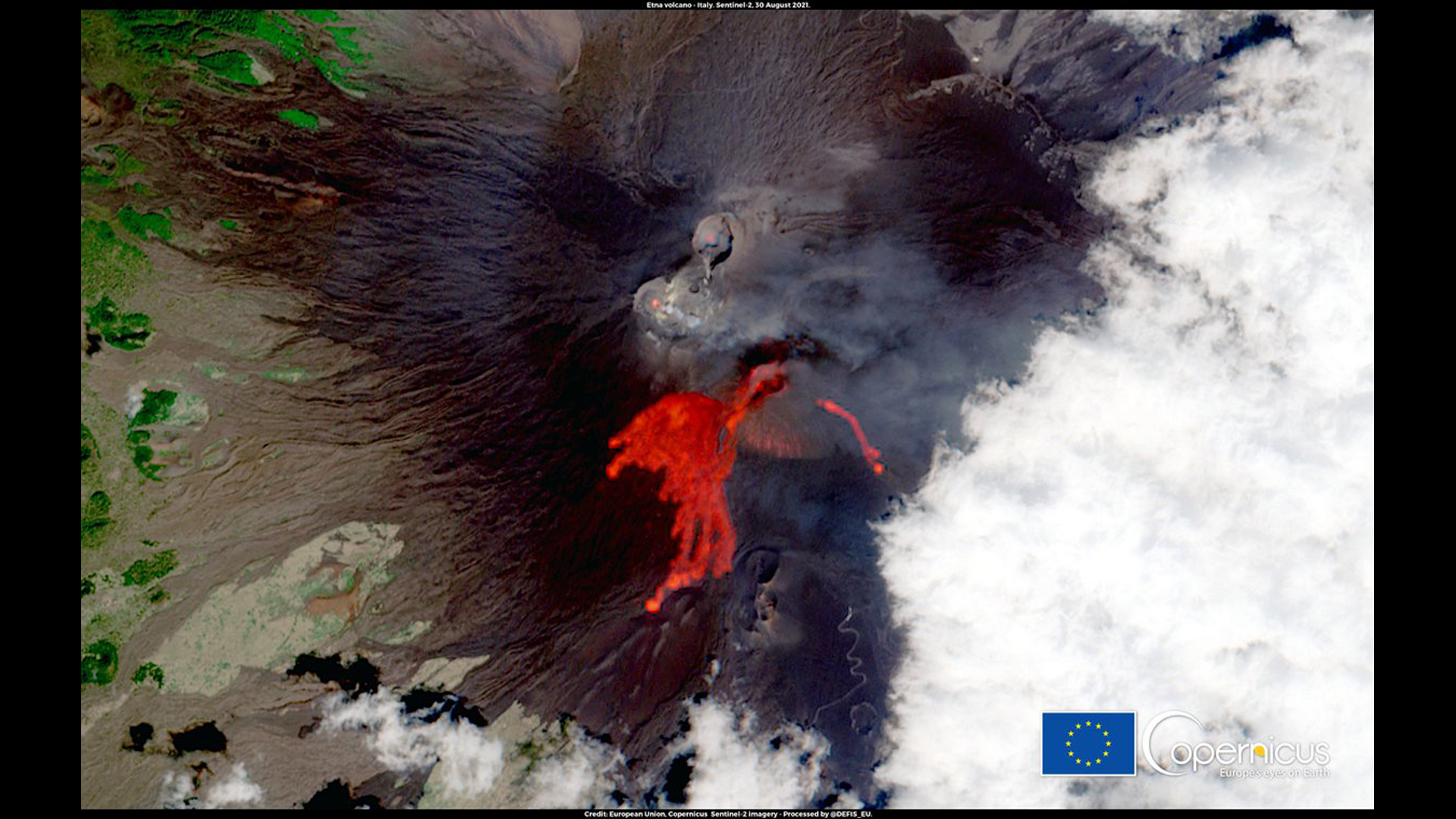Mount Etna volcano erupts for 50th time of 2021 in this satellite photo
Europe's most active volcano, Mt Etna, has been spewing out lava, gas and ash since February.

Italy's Mount Etna volcano erupted for the 50th time this year over the weekend and the European Sentinel 2 satellite captured the epic view from space.
Mount Etna, towering above the Mediterranean island of Sicily, has been experiencing a busy season this year and saw its latest eruption on Sunday (Aug. 29). This view was captured by the Sentinel 2 satellite as it appeared on Aug. 30, according to the European Commission's office of the Director-General for Defence Industry and Space, which shared the image on Twitter.
Related: In images: 10 incredible volcanoes in our solar system
The amount of lava Etna has spewed since Feb.16 added 100 feet (30 meters) in height to the volcano's southeast crater. One of Etna's four summit craters, the southeastern peak now stands at a little over 11,000 feet (3,357 meters) high, having surpassed the 10,900-foot (3,324 m) northeastern crater, which had dominated the volcano for four decades.
According to volcanologist Boris Behncke, of the National Institute for Geophysics and Volcanology (INGV), which operates an observatory just below the fuming giant, scientists knew Etna had been up to something since late 2020 when it started burping out clouds of ash and gas.
"Etna was building up for something big (we feared an eruption from the flank) with intense seismic activity, ground deformation, and degassing," Behncke said on Twitter. "On 16 February the real series of paroxysms [eruptions] started, seismicity stopped, ground deformation reversed to deflation."
... Etna was building up for something big (we feared an eruption from the flank) with intense seismic activity, ground deformation, and degassing. On 16 February the real series of paroxysms started, seismicity stopped, ground deformation reversed to deflation (2/2)August 31, 2021
Satellites have been keeping an eye on Etna ever since. The study revealing the volcano's unprecedented growth used data from the Pleiades constellation operated by Europe's aerospace company Airbus. The Sentinel satellites of the Copernicus Earth observation program, run by the European Union, have, among others, closely monitored the amount of the dangerous sulfur dioxide escaping from Etna's intestines.
Get the Space.com Newsletter
Breaking space news, the latest updates on rocket launches, skywatching events and more!
The environmental data analysis platform ADAM posted an image on Twitter based on data from the Copernicus Sentinel 5P satellite on Monday (Aug 30) showing the sulfur dioxide plume from the latest eruption spreading over Greece and Turkey.
The SO2 plume of the 50th paroxysm of #Etna from August 29th captured today, August 30 by #Copernicus #Sentinel5p, over #Greece and #Turkey. Visible also some light emissions still on going. @CultureVolcan #volcano #Sicily #Italy pic.twitter.com/lUqfZz05ooAugust 30, 2021
Volcanic plumes can reach very high altitudes and can potentially impact air traffic. A similar plume emitted by Etna in early April was detected at the altitude of 23,000 feet (7,000 m). On ground level, sulfur dioxide can irritate the human respiratory system and trigger conditions such as asthma in susceptible individuals.
Mount Etna is thought to have started as a submarine volcano that slowly grew above sea level as it erupted, time and again, gradually increasing its height with solidified lava, according to NASA's Earth Observatory. It's now largely covered with historic lava flows from eruptions that happened up to 300,000 years ago.
Follow Tereza Pultarova on Twitter @TerezaPultarova. Follow us on Twitter @Spacedotcom and on Facebook.
Join our Space Forums to keep talking space on the latest missions, night sky and more! And if you have a news tip, correction or comment, let us know at: community@space.com.

Tereza is a London-based science and technology journalist, aspiring fiction writer and amateur gymnast. Originally from Prague, the Czech Republic, she spent the first seven years of her career working as a reporter, script-writer and presenter for various TV programmes of the Czech Public Service Television. She later took a career break to pursue further education and added a Master's in Science from the International Space University, France, to her Bachelor's in Journalism and Master's in Cultural Anthropology from Prague's Charles University. She worked as a reporter at the Engineering and Technology magazine, freelanced for a range of publications including Live Science, Space.com, Professional Engineering, Via Satellite and Space News and served as a maternity cover science editor at the European Space Agency.









